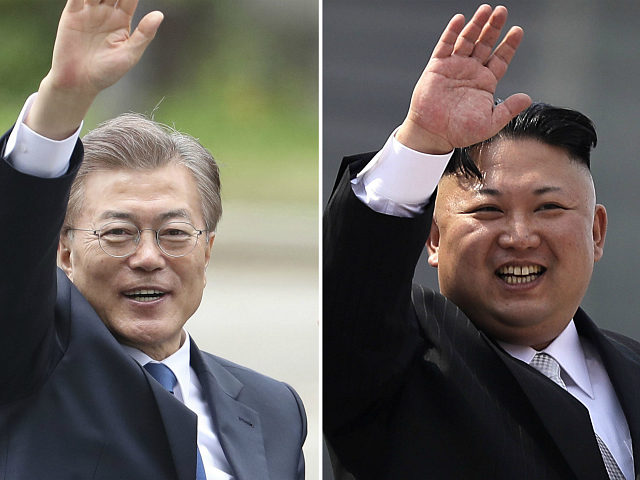Final preparations were completed Thursday in the border village of Panmunjom for Friday’s summit meeting between North Korean dictator Kim Jong-un and South Korean President Moon Jae-in.
The preparations were extensive. Some 3,000 journalists will be covering the event representing 461 media organizations from 41 countries, including Reuters, Bloomberg News, and China’s Xinhua. A press center the size of a football stadium has been created for them. The only larger media event on the Korean Peninsula was the Pyeongchang Winter Olympics.
The Panmunjom press center also includes facilities for several South Korean agencies, including the presidential Blue House, the Ministry of Foreign Affairs, the Ministry of Culture, and of course the Ministry of Unification, which is the lead agency for dealings with North Korea.
The North Korean delegation will include Kim Yong-nam, president of the Supreme People’s Assembly, who is technically the head of the North Korean state; Kim Yong-chol, vice chairman of the ruling Workers’ Party, whose presence is somewhat controversial because he has been held responsible for the 2010 sinking of the South Korean ship Cheonan; Ri Son-gwon, who heads North Korea’s much less affable version of the South Korean Ministry of Unification; Foreign Minister Ri Yong-ho, arguably the Kim regime’s best negotiator; and Kim Yo-jong, younger sister of the dictator, who spearheaded the North Korean “charm offensive” at the Winter Olympics.
A rehearsal for the summit was held by South Korean officials on Thursday to ensure every participant knew their positions when Moon and Kim meet. The two leaders are scheduled to perform a ceremonial walk of friendship across a wooden footbridge and inspect a South Korean honor guard before their meeting begins.
Kim is expected to walk across the border on foot, becoming the first North Korean leader to tread upon South Korean soil since the end of the Korean War in 1953.
The meeting itself will take place in the “Peace House” of Panmunjom, which was originally constructed for a North-South meeting in 1980. The Peace House has been extensively refurbished for the summit, including a new oval-shaped conference table whose design is intended to bring the participants closer together, echoing the shape of two bridges joining. The distance between Moon and Kim’s seats at the table has been measured down to a fraction of an inch.
Despite these lavish renovations, which doubtless include top-of-the-line restroom facilities, Kim Jong-un will probably bring his own toilet to the summit. Not only does he disdain public restrooms, but North Korean security fears the great leader’s bodily excretions could be examined by adversaries to obtain sensitive information about his physical health.
In addition to discussing denuclearization, President Moon has said he hopes the summit can begin the process of formally ending the Korean War, which concluded with an armistice rather than a peace treaty.
To that end, Moon and Kim are scheduled to discuss a number of symbolic gestures that will make the demilitarized zone a bit less militarized, such as removing some guard posts, disarming troops stationed in Panmunjom, opening a liaison office with staff from both sides of the border, and opening additional lines of communication between the two countries.
Writing for Fox News on Thursday, Harry J. Kazianis of the Center for the National Interest predicted that North Korea is “surely looking for investment from the South to rebuild their economy, which is less than 1 percent the size of South Korea’s.”
Kazianis anticipated that major South Korean investments are unlikely in the short term, so Kim is likely to press for the relaxation of sanctions imposed unilaterally by Seoul and the resumption of joint economic projects. In the longer term, he notes that North Korea potentially offers “trillions of dollars in untapped underground mineral resources and a massive labor force,” so South Korean businessmen will be interested in developing opportunities there.
Share prices of companies historically involved in joint projects with North Korea have been rising as anticipation builds for the summit, while even small South Korean businessmen perched near the northern border are excited about the prospect of cross-border trade resuming. Real-estate prices near the DMZ are hitting 20-year highs in anticipation of greater trade opportunities and joint industrial projects.
Naturally, a vital purpose of this summit will be setting the stage for the even more significant meeting between Kim and U.S. President Donald Trump, tentatively scheduled for May or June. Kazianis suggested that one of Moon’s objectives will be to determine just how serious Kim is about denuclearization and, perhaps most importantly, whether he is willing to permit the sort of intrusive international inspections regime that would be necessary to verify his nuclear program has been canceled.

COMMENTS
Please let us know if you're having issues with commenting.